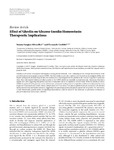Effect of ghrelin on glucose-insulin homeostasis: therapeutic implications

Ver/Abrir
Use este enlace para citar
http://hdl.handle.net/2183/18399
Excepto si se señala otra cosa, la licencia del ítem se describe como Creative Commons Attribution 3.0 International License (CC-BY 3.0)
Colecciones
- Investigación (FCS) [1261]
Metadatos
Mostrar el registro completo del ítemTítulo
Effect of ghrelin on glucose-insulin homeostasis: therapeutic implicationsFecha
2010Cita bibliográfica
Sangiao-Alvarellos S, Cordido F. Effect of ghrelin on glucose-insulin homeostasis: therapeutic implications. Int J Pept. 2010;2010:234709.
Resumen
[Abstract] Ghrelin is a 28-amino-acid peptide that displays a strong growth hormone- (GH-) releasing activity through the activation of the growth hormone secretagogue receptor (GHSR). The first studies about role of ghrelin were focused on its orexigenic ability, but despite indisputable pharmacological data, the evidence for a physiological role for ghrelin in the control of appetite is much less clear. Mice with targeted deletion of either ghrelin or the GHSR exhibit an essentially normal metabolic phenotype when fed a regular chow diet, suggesting that ghrelin may have a redundant role in the regulation of food intake. RNAs for ghrelin as well as GHSR are expressed in the pancreas of rats and humans and several studies propose that ghrelin could have an important function in glucose homeostasis and insulin release, independent of GH secretion. Low plasma ghrelin levels are associated with elevated fasting insulin levels and insulin resistance, suggesting both physiological and pathophysiological roles for ghrelin. For this reason, at least theoretically, ghrelin and/or its signalling manipulation could be useful for the treatment or prevention of diseases of glucose homeostasis such as type 2 diabetes.
Versión del editor
Derechos
Creative Commons Attribution 3.0 International License (CC-BY 3.0)
ISSN
1687-9775
1687-9767
1687-9767






